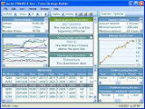Central banks & Release calendar
- The US Federal Reserve
- European Central Bank
- Bank of Japan
- Bank of England
- Swiss National Bank
- Bank of Canada
- Reserve Bank of Australia
- Reserve Bank of New Zealand
- Other Foreign Central Banks
The Federal Reserve System is the central bank of the United States. It was founded by Congress in 1913 to provide the nation with a safer, more flexible, and more stable monetary and financial system.
| Month | Date |
|---|---|
| January | 26-27 |
| March | 16 |
| April | 27-28 |
| June | 22-23 |
| August | 10 |
| September | 21 |
| November | 2-3 |
| December | 14 |
The ECB is the central bank for Europe's single currency, the euro. The ECB’s main task is to maintain the euro's purchasing power and thus price stability in the euro area. The euro area comprises the 12 European Union countries that have introduced the euro since 1999.
| Month | Date |
|---|---|
| January | 14 |
| February | 4 |
| March | 4 |
| April | 8 |
| May | 6 |
| June | 10 |
| July | 8 |
| August | 5 |
| September | 2 |
| October | 7 |
| November | 4 |
| December | 2 |
The Bank of Japan is an organization that contributes to the stability of the daily lives of the people and sound development of the national economy by appropriately controlling the volume of money in the economy and ensuring the smooth circulation of money.
| Month | Date |
|---|---|
| January | 25 |
| February | 17 |
| March | 16 |
| April | 6 and 29 |
| May | 20 |
| June | 14 |
| July | 14 |
| August | 9 |
| September | 6 |
| October | 27 |
| November | 15 |
| December | 20 |
The Bank of England is the central bank of the United Kingdom. Sometimes known as the 'Old Lady' of Threadneedle Street, the Bank was founded in 1694, nationalised on 1 March 1946, and gained independence in 1997. Standing at the centre of the UK's financial system, the Bank is committed to promoting and maintaining monetary and financial stability as its contribution to a healthy economy.
| Month | Date |
|---|---|
| January | 4 |
| March | 4 |
| April | 8 |
| May | 3 |
| June | 10 |
| July | 8 |
| August | 5 |
| September | 9 |
| October | 7 |
| November | 4 |
| December | 9 |
The Swiss National Bank conducts the country’s monetary policy as an independent central bank. In so doing, it creates an appropriate environment for economic growth. The National Bank is obliged by the Constitution and statute to act in accordance with the general interests of the country. Its policy goal is price stability, while taking into account the economic situation.
| Month | Date | March | 11 |
|---|---|
| June | 17 |
| September | 16 | December | 16 |
The Bank of Canada is the nation's central bank. We have responsibilities for Canada's monetary policy, bank notes, financial system, funds management and retail debt. Our principal role, as defined in the Bank of Canada Act, is "to promote the economic and financial welfare of Canada."
| Month | Date |
|---|---|
| January | 19 |
| March | 2 |
| April | 20 | June | 1 |
| July | 20 |
| September | 8 |
| October | 19 |
| December | 7 |
The Reserve Bank of Australia's (RBA) main responsibility is monetary policy. Policy decisions are made by the Reserve Bank Board, with the objective of achieving low and stable inflation over the medium term.
| Month | Date |
|---|---|
| February | 2 |
| March | 2 |
| April | 6 |
| May | 4 |
| June | 1 |
| July | 6 |
| August | 2 |
| September | 7 |
| October | 5 |
| November | 2 |
| December | 7 |
The Reserve Bank of New Zealand is New Zealand's central bank, and its overall purpose is to maintain the stability and efficiency of the financial system.
| Month | Date |
|---|---|
| January | 27 |
| March | 10 |
| April | 28 |
| June | 9 |
| July | 28 |
| September | 15 |
| October | 27 |
| December | 8 |
- The role of central banks
- Monetary policies
- Interest rates 101
- Central banks you need to know

1. ABC of fundamental analysis
- What is fundamental analysis?
- Exchange rates and supply and demand
- Top 5 factors that affect exchange rate
- Political and economical performance
2. Central banks, Monitory policies & Interest rates
3. Fundamental indicators
- Macroeconomic indicators
- Inflation indicators
- Employment indicators
- How to use fundamental indicators
4. Using fundamental factors

Forex Educational Articles & News

There are many factors that affect exchange rates of currencies. However some are more important in currency trading than others. These are; Interest and Inflation rates, Trade balance, Currency market speculation, Foreign investment and Central bank market intervention. Learn how to use these factors in your forex tra ...




